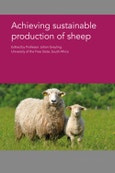effectively managed. Achieving sustainable production of sheep will be a standard reference for animal and food scientists in universities, government and other research centres and companies involved in supporting sheep farming.
Audience: Academic researchers in animal (esp. small ruminant) science; Government agencies responsible for food safety/quality and livestock farming; Meat processors
Table of Contents
Part 1 Quality issues1. Factors affecting sheep carcass characteristics: Nicola M. Schreurs and Paul R. Kenyon, Massey University, New Zealand;
2. Animal and on-farm factors affecting sheep and lamb meat quality: Nicola M. Schreurs and Paul R. Kenyon, Massey University, New Zealand;
3. Improving sheep wool quality: E. K. Doyle, University of New England, Australia;
4. Producing quality milk from sheep: Sam W. Peterson, Massey University, New Zealand;
Part 2 Genetics and breeding
5. Mapping the sheep genome: Noelle E. Cockett, Utah State University, USA; Brian Dalrymple, University of Western Australia, Australia; James Kijas, CSIRO, Australia; Brenda Murdoch, University of Idaho, USA; and Kim C. Worley, Baylor College of Medicine, USA;
6. Advances in sheep breeding: Julius van der Werf, School of Environmental & Rural Science, University of New England, Australia; and Andrew Swan and Robert Banks, Animal Genetics and Breeding Unit, University of New England, Australia;
7. Improving reproductive efficiency of sheep: J. P. C. Greyling, University of the Free State, South Africa;
Part 3 Animal nutrition and health
8. Sustainably meeting the nutrient requirements of grazing sheep: D. K. Revell, Revell Science and The University of Western Australia, Australia;
9. Sheep nutrition: formulated diets: M. L Thonney, Cornell University, USA;
10. Maintaining sheep flock health: an overview: Neil Sargison, University of Edinburgh, UK;
11. Bacterial and viral diseases affecting sheep: Francesca Chianini, Moredun Research Institute, UK;
12. Sustainable control of gastrointestinal nematode parasites affecting sheep: W. E. Pomroy, Massey University, New Zealand;
13. Understanding and improving immune function in sheep: Gary Entrican and Sean Wattegedera, Moredun Research Institute, UK;
Part 4 Animal welfare
14. Understanding sheep behaviour: R. Nowak, INRA/Université de Tours, France;
15. Validating indicators of sheep welfare: N.J. Beausoleil and D.J. Mellor, Massey University, New Zealand;
16. Improving the welfare of ewes: A. L. Ridler and K. J. Griffiths, Massey University, New Zealand;
17. Improving the welfare of lambs: K. Stafford, Massey University, New Zealand;
18. Humane transport, lairage and slaughter of sheep: P. H. Hemsworth and E. C. Jongman, University of Melbourne, Australia;
Part 5 Sustainability
19. Assessing the environmental impact of sheep production: S. F. Ledgard, AgResearch Ruakura Research Centre, New Zealand
20. Nutritional strategies to minimise emissions from sheep: C. Jamie Newbold, Eli R. Saetnan and Kenton J. Hart, Aberystwyth University, UK








